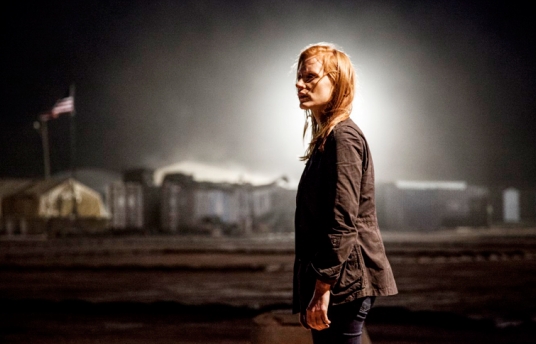Now Playing in Doha! : Zero Dark Thirty
Jan 31, 2013

By Alexander Wood
The theatre is completely black as the audio of pilots, citizens and emergency dispatchers provide a visceral account of the moments that began the war on terror–a battle that irreparably changed countless nations and the people who call them home. The darkness is dissolved and reveals various ‘black sites’ designed to interrogate and break those who have been captured by US intelligence. Moving through a decade of history and the struggles to track down Osama bin Laden, the most infamous man in the world, the film is relentless as it strives to forge a historic and emotional portrait of human history.
Beginning the film in total darkness is a powerful technique that does not rely on the iconic imagery of the planes hitting the world trade center on September 11th, 2001. The scene uses the collective history of viewers to create a mental image, spurred on by the sounds of those trapped in the towers and planes. By featuring just voices, the film becomes universal—allowing the viewer to visualise the victims. The events of September 11th offer some of the most iconic imagery in the history of photography, images which have been imprinted on the collective consciousness of millions. The film’s director, Kathryn Bigelow, understands that to feel and comprehend the events of that day the audience is not required to see the images or footage that began the war on terror—because they have already lived them.
Allowing the viewer to enter the film in this way enables them to be self-reflexive, remembering the exact moment in time when they heard or saw planes hitting the twin towers and can project their experience on the screen at the beginning of the film. In this respect, the audience is in charge of how they view and react to the first 30 seconds of ‘Zero Dark Thirty’. Giving power to the viewers is also mirrored by the type of handheld filming used throughout. By using this technique it gives the viewer the sense of being in the scene and witnessing events first hand. The director has created a film that allows many points of entry for the audience and encourages them to define their own journey through the cinematic work.
The film is broken into various acts that are defined by the location or the name of the terrorist cell that the camera is focusing on. The first time the viewer is exposed to this division is with the introduction of the ‘Saudi Group’. By over laying text on the film and also providing black title cards, it gives the audience a definitive sense of time and place. Through the use of these title cards for a story that spans a decade, it becomes easy to follow the magnitude of the information being provided on screen. Titles like ‘Human Error’, ‘Tradecraft’ and ‘The Canaries’ provide a unique element to the filmmaking and often foreshadow significant events to come. Using the title cards allows the audience to once again imagine the events to come, piecing together a narrative to which they know the end. By accentuating scenes and locations with exact historic details, it adds an element of accuracy to the events taking place on screen, rather than creating another diluted Hollywood take on history.
At times throughout the film there is the use of detainee footage that depicts their torture and inhumane treatment. These segments feature grainy, overexposed footage that add a further element of realism while providing a glimpse into the brutality that accompanies the USA’s pursuit for the man behind 9/11. Some of the most graphic scenes of the film were these torture sequences, which provide a vivid account of the treatment of detained prisoners. The polished image of the United States does not shine as brightly as one might expect for a Hollywood film, allowing the viewer to more readily accept this film as a reflection of non-fiction.
Subsequently, there are some attempts to normalise Arabs and Muslims throughout the film and create a more multi-faceted perspective. Many of the supporting and lead characters speak Arabic, ensuring that some element of the Arab perspective will be captured, even if it is only the language. One of the high-ranking CIA agents in Washington is shown praying in his office prior to a meeting. By including this scene it shows that followers of Islam have varying degrees of views towards Osama bin Laden. It was refreshing to see that Kathryn Bigelow attempted to capture a nuanced perspective of Arabs and Muslims.
What is unique about the film is the fact that it moves full circle – ending as it had begun. The final moments of the narrative shows protagonist Maya (Jessica Chastain) boarding a military cargo plane. Silence fills the scene and she begins to cry as the weight of a decade of intelligence work can finally be reconciled. What is important about this scene is that the individual who was battling terror is always in focus, not the nation as a whole. The final seconds of the film show Maya’s catharsis and then slip back to the black screen that initiated the viewer’s experience.
Overall the cinematography, acting and plot stand on their own, providing a compelling account for viewers of all cultures and backgrounds. Both the beginning and end of the film are given to the audience to interpret and imagine—successfully creating a personal narrative that is a reflection of the experiences of those who watch it.
video#1